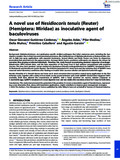Mostrar el registro sencillo del ítem
A novel use of Nesidiocoris tenuis (Reuter) (Hemiptera: Miridae) as inoculative agent of baculoviruses
| dc.creator | Gutiérrez-Cárdenas, Oscar Giovanni | es_ES |
| dc.creator | Adán, Ángeles | es_ES |
| dc.creator | Medina, Pilar | es_ES |
| dc.creator | Muñoz, Delia | es_ES |
| dc.creator | Caballero Murillo, Primitivo | es_ES |
| dc.creator | Garzón, Agustín | es_ES |
| dc.date.accessioned | 2023-10-30T13:15:40Z | |
| dc.date.available | 2023-10-30T13:15:40Z | |
| dc.date.issued | 2023 | |
| dc.identifier.citation | Gutiérrez‐Cárdenas, O. G., Adán, Á., Medina, P., Muñoz, D., Caballero, P., & Garzón, A. (2023). A novel use of Nesidiocoris tenuis (Reuter) (Hemiptera: Miridae) as inoculative agent of baculoviruses. Pest Management Science, 79(11), 4274-4281. https://doi.org/10.1002/ps.7624 | en |
| dc.identifier.issn | 1526-498X | |
| dc.identifier.uri | https://hdl.handle.net/2454/46686 | |
| dc.description.abstract | Background: Alphabaculoviruses are Lepidoptera-specific virulent pathogens that infect numerous pests, including the Spodoptera complex. Due to their low environmental persistence, the traditional use of Alphabaculoviruses as bioinsecticides consist in high-rate spray applications with repeated treatments. Several abiotic and biotic factors can foster its dispersion, promoting their persistence in the agroecosystem. Amongst biotic factors, predatory arthropods can disperse the viruses by excretion after preying on infected individuals. Therefore, this study focused on promoting predator's ingestion of nucleopolyhedrovirus (NPV)-treated diets, and the later exposition of the insect host to leaf surfaces contaminated with predator excreta. The virus–host–predator system studied was Spodoptera littoralis nucleopolyhedrovirus (SpliNPV), Spodoptera littoralis (Boisduval) and Nesidiocoris tenuis (Reuter). The infective potential of N. tenuis feces and the retention time of SpliNPV were assessed under laboratory conditions after feeding on treated diets (sucrose solution and Ephestia kuehniella eggs). Results: Mortality of S. littoralis larvae was lower via N. tenuis excretion than in positive control (spray application) in the first infection cycle, together with a delay in host death. In the second infection cycle, both SpliNPV-treated diets triggered 100% mortality. Both diets allowed the transmission of SpliNPV, with a faster excretion via sucrose solution compared to E. kuehniella eggs. SpliNPV remained in N. tenuis digestive tract and was viable after excretion at least for 9 days for both diets. Conclusions: This study demonstrated the potential of the predator N. tenuis as inoculative agent of baculoviruses, representing a new alternative that, along with inundative applications, might contribute to improve pest management strategies. | en |
| dc.description.sponsorship | This study was funded by the Spanish Ministry of Science and Innovation through the State Research Agency with the projects entitled: AGL2017-83498-C2-2-RB ‘Development of effective baculovirus-based insecticides with a broad spectrum of hosts and advances towards its integration in IPM programs’ and PID2020-117062RB-C22 ‘Exploiting entomophagous insects to enhance the control of Spodoptera spp through the use of baculovirus’. OG Gutiérrez-Cárdenas acknowledges the Government of Mexico and the National Council of Humanities, Science and Technology (CONAHCYT) for the PhD research grant number 717840-2018. | en |
| dc.format.mimetype | application/pdf | en |
| dc.language.iso | eng | en |
| dc.publisher | Wiley | en |
| dc.relation.ispartof | Pest Management Science 2023; 79: 4274–4281 | en |
| dc.rights | © 2023 The Authors. This is an open access article under the terms of the Creative Commons Attribution-NonCommercial-NoDerivs License, which permits use and distribution in any medium, provided the original work is properly cited, the use is non-commercial and no modifications or adaptations are made. | en |
| dc.rights.uri | http://creativecommons.org/licenses/by-nc-nd/4.0/ | |
| dc.subject | Alphabaculovirus | en |
| dc.subject | Bioinsecticides | en |
| dc.subject | Microbiological control | en |
| dc.subject | Predatory mirids | en |
| dc.subject | Spodoptera littoralis | en |
| dc.title | A novel use of Nesidiocoris tenuis (Reuter) (Hemiptera: Miridae) as inoculative agent of baculoviruses | en |
| dc.type | Artículo / Artikulua | es |
| dc.type | info:eu-repo/semantics/article | en |
| dc.date.updated | 2023-10-30T12:59:39Z | |
| dc.contributor.department | Institute for Multidisciplinary Research in Applied Biology - IMAB | en |
| dc.rights.accessRights | Acceso abierto / Sarbide irekia | es |
| dc.rights.accessRights | info:eu-repo/semantics/openAccess | en |
| dc.identifier.doi | 10.1002/ps.7624 | |
| dc.relation.projectID | info:eu-repo/grantAgreement/AEI/Plan Estatal de Investigación Científica y Técnica y de Innovación 2013-2016/AGL2017-83498-C2-2-R/ES/ | en |
| dc.relation.projectID | info:eu-repo/grantAgreement/AEI/Plan Estatal de Investigación Científica y Técnica y de Innovación 2017-2020/PID2020-117062RB-C22/ES/ | en |
| dc.relation.publisherversion | https://doi.org/10.1002/ps.7624 | |
| dc.type.version | Versión publicada / Argitaratu den bertsioa | es |
| dc.type.version | info:eu-repo/semantics/publishedVersion | en |
Ficheros en el ítem
Este ítem aparece en la(s) siguiente(s) colección(ones)
La licencia del ítem se describe como © 2023 The Authors. This is an open access article under the terms of the Creative Commons Attribution-NonCommercial-NoDerivs License, which permits use and
distribution in any medium, provided the original work is properly cited, the use is non-commercial and no modifications or adaptations are made.



